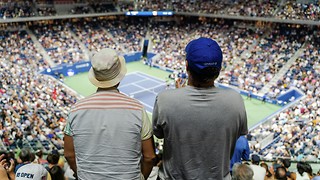Encounters With Space
Siobhan Forshaw reflects on the nature of the museum: what is it, what does it do, and what can it achieve in the future?

Aiming to contextualise, yet simultaneously robbing of true context, the art museum is a self-contradictory medium of experience. Once reserved exclusively for those privileged in matters of taste and finance, the ‘noble cabinet’ has evolved into a gigantic and powerful sphere of influence. They are spaces within the public domain; owned and shared by all of us – we visit them in order to encounter the new and the old and the very old, housed together under an institutional roof. In 2000, the cultural theorist Bill Brown attended to this issue of our interaction with the past; ‘As they circulate through our lives, we look through objects to see what they disclose about history, society, nature, or culture – above all, what they disclose about us … We look through objects because there are codes by which our interpretive attention makes them meaningful.’ We can infer this into Joseph Kosuth’s 1965 installation ‘One and Three Chairs’, which juxtaposes conflicts in the representation of a thing: the two-dimensional pictorial depiction of the chair flattens and reduces its utility, and the textual definition transcribes its characteristics, but even the presence of the object within the installation is a denial of the thing’s social place, for the context of the museum forbids tactile interaction. So we are forced to consider the object outside of its utility; as a thing.
The dialectical tension between archiving and preserving the past, whilst simultaneously pushing challenging and progressive artworks is clear in our national spaces. The ceramics department of the Victoria and Albert Museum looks as though the contents of a million grannies’ figurines have been shoved together, as if there is a vague awareness that they for some reason should be preserved, but no sincere justification of the fact. This pushes their current Ai Wei Wei Dropping the Urn exhibit into a tiny room – with no space to contemplate, the collection is drained of any real impact. Museum anthropologist (yes, they exist) Jeanne Cannizzo has addressed the various issues surrounding the negotiation of space within the museum context; ‘There is nothing natural about museums, their collections, or the way in which those objects are presented to us. For museums are always fictional in that they are always created or constructed by us in a particular set of social and historical circumstances; they are negotiated realities.’ He understands the intense problem of artificiality in artistic representation, one that has been grappled with by artists and curators arguably since Duchamp’s Fountain. ‘Found’ art brings the outside into the artistic domain, and it is this very action of re-contextualising that gives it the status of Art. By natural contrast, commissioned art within the public domain is regularly justified as a tool for social redevelopment and urban reinvigoration. Regularly attacked both physically and through the media, public art gives a controversial account of concepts of the privatisation of space and the rights of the community to encounter art in a way they choose.

The ever-approaching-but-never-quite-here London Olympics piles pressure on particularly the national museums to deliver quality and innovation in its exhibits; to act as cultural ambassadors; to care for the legacy of the past whilst creating a legacy for the future. As a city keen to prove its cultural worth, the Olympic Delivery Authority is also commissioning public artwork that naturally remains within the bounds of the offensively inoffensive – giant crayons on the waterfront, anyone? Britain is fiercely proud (and rightly so) of its uniquely free museums and galleries, but the problem of money dogs these institutions. The shackles of corporate sponsorship suppress the political and ethical values of our museums. Consider the position of Tate, whose popular public image has been severely blemished by their partnership with British Petroleum. The appalling transgression of human rights committed by BP in the Gulf of Mexico, and the ensuing public relations catastrophe, contractually obliged Tate to speak in defense of BP as ‘one of the most important sponsors of the arts in the UK, supporting Tate as well as several other leading institutions’. More and more, artists are looking towards independent artistic commissioners to support their work. In operation since the early 1990s, the art production outlet Artangel has produced over fifty major new commissions including Rachel Whiteread’s House (1992), Michael Landy’s Breakdown (2001), Francis Alys’ Seven Walks (2005) and Heiner Goebbel’s Stifters Dinge (2008). Free from the political constraints of the gallery space, the organisation is free to commission and promote work that subscribes only to its own claims, in whichever context it needs.

Why do we, natives of the digital age, continue to respect and require the physicality of the museum space and presence? Perhaps for a similar reason that film for film cameras remains in popular production, despite the celebration of technological advancement in the ease and economics of digital photography: the tangibility of space remains paramount to our aesthetic gratification. However, our artistic awareness and interaction should not and cannot remain limited within these buildings. Art has always played a huge role in political movements, and activist art must force itself into the public domain in order to effect genuine social change. It must not allow itself to stagnate within the static arena of the museum – risking the exchange of their own priorities for the sensibilities of the institution, as with Tate’s decision to cordon off Ai Wei Wei’s Sunflower Seeds at the Turbine Hall in 2010, robbing the work of its tactility and context. To remain relevant spaces of artistic encounter, our museums need to re-evaluate their social position and priorities, loosening, though not relinquishing, ties with the past; engaging with the present, in order move into the future.
 Features / The community Cambridge accommodation creates (and doesn’t)9 August 2025
Features / The community Cambridge accommodation creates (and doesn’t)9 August 2025 Features / Incoming freshers and their hopes, fears and expectations for Cambridge 12 August 2025
Features / Incoming freshers and their hopes, fears and expectations for Cambridge 12 August 2025 News / Trinity sells O2 Arena lease for £90m12 August 2025
News / Trinity sells O2 Arena lease for £90m12 August 2025 News / Local group objects to ‘bulky’ new Christ’s library13 August 2025
News / Local group objects to ‘bulky’ new Christ’s library13 August 2025 News / Uni welcomes new students14 August 2025
News / Uni welcomes new students14 August 2025








